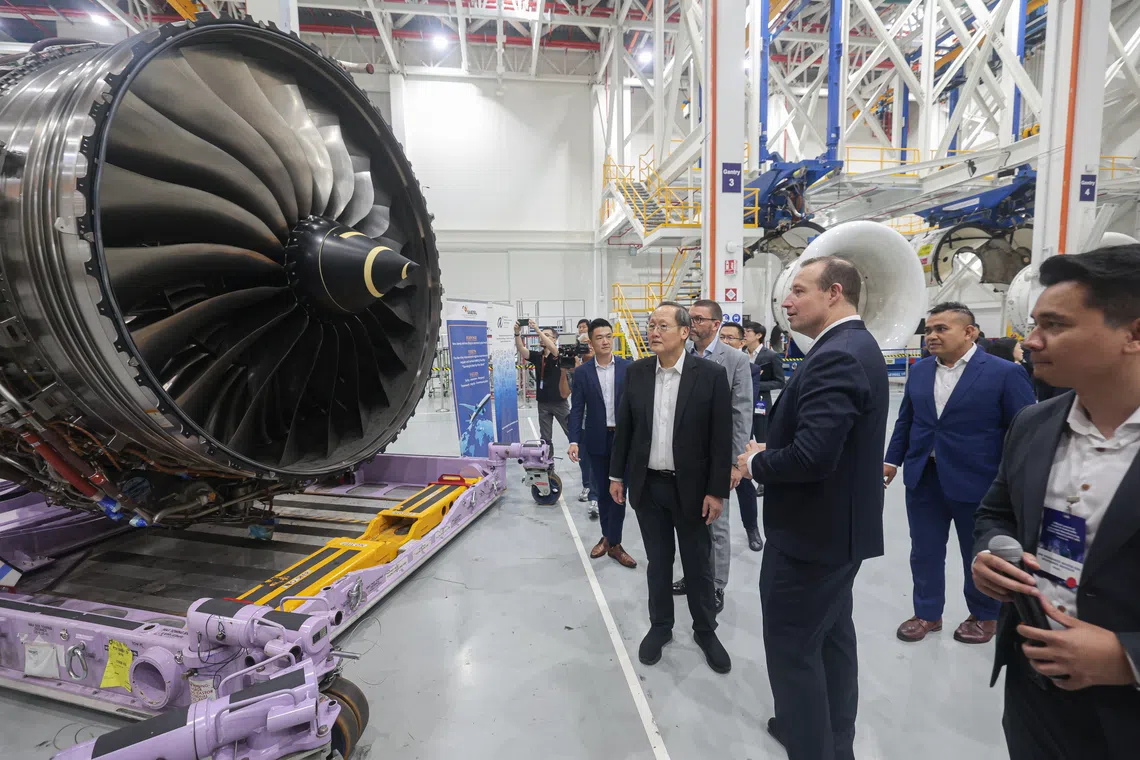Rolls-Royce factory in S’pore gets a boost from expansion of initiative to raise productivity
Sign up now: Get ST's newsletters delivered to your inbox

Minister-in-charge of Energy and Science and Technology Tan See Leng (centre) touring the Rolls-Royce factory on Oct 3.
PHOTO: LIANHE ZAOBAO
Follow topic:
- Rolls-Royce's Singapore factory productivity increased by over 20% due to a joint lab with SAESL and A*Star.
- SAESL, a Rolls-Royce joint venture, enhanced MRO capabilities and shortened lead times.
- Phase two will receive $34M investment, engaging SMEs and strengthening Singapore's aerospace hub.
AI generated
SINGAPORE - Aircraft engine-maker Rolls-Royce’s factory in Singapore is getting a boost as a research collaboration which has increased its productivity by over 20 per cent gears up into its second phase.
The company’s joint lab with Singapore Aero Engine Services (SAESL) and A*Star was expanded on Oct 3.
The first phase of the collaboration, launched in 2017, resulted in the automation of processes like the coating of fans in aircraft engines.
These improvements allowed Rolls-Royce to raise its output without expanding its physical factory, said Dr Tan See Leng, Minister-in-charge of Energy and Science and Technology.
He added: “Improvements like these are expected to generate operational efficiencies for Rolls-Royce and SAESL over the next decade.”
SAESL, a joint venture between Rolls-Royce and SIA Engineering Company, has also raised its maintenance, repair and overhaul (MRO) capabilities under the collaboration.
SAESL is one of the world’s largest MRO companies servicing Rolls-Royce’s Trent family jet engines.
More than 20 per cent of these engines pass through SAESL, with the company supporting over 30 airlines globally, including national carrier Singapore Airlines, Dubai-based Emirates and TAP Air Portugal, the flag carrier of Portugal.
It has separately embarked on an expansion plan to increase its annual maintenance capacity in Singapore
Technologies from automated inspections to AI-enabled monitoring have shortened lead times, said SAESL’s chief executive Chris Pattinson.
He expects the innovations to save his firm more than $17 million over the next decade.
Rolls-Royce, SAESL and A*Star had invested $68 million into the first phase of the joint lab, which focused on improving process efficiencies and implementing advanced manufacturing technologies.
Nearly $34 million more will be invested into the lab’s second phase, to allow firms to meet the rising global demand for aviation products and services.
Mr Neil Mantle, Rolls-Royce’s director of manufacturing engineering and materials, said the collaboration fits into the company’s “wider transformation to become a high-performing, competitive and resilient business”.
He expects the second phase, along with “internal improvement initiatives of digitisation and advanced manufacturing, to enable us to expand production capacity by over 30 per cent over the next decade”.
More than 200 local small and medium-sized enterprises (SMEs) have also been engaged as part of the collaboration, creating over $4.5 million in business opportunities.
“The next phase of the joint lab will build on these successes to strengthen Singapore as a hub for next-generation aerospace manufacturing and servicing,” said Dr Tan, who is also the Minister for Manpower.
Singapore is home to more than 130 aerospace companies specialising in research and development, manufacturing and related services.
The equivalent of about one of every 10 aircraft as well as one out of five engines is serviced in the country, according to official estimates.
Manufacturing output of the Singapore aerospace sector has also seen strong growth, expanding by 36 per cent in August from a year earlier.
A*Star expanded another collaboration with Abrasive Engineering, an SME specialising in surface finishing, on Oct 3.
The first phase saw the firm tapping technologies to double its revenue to $12 million, and expanding overseas to South Korea and China.
The second phase of the collaboration will focus on building next-generation surface treatment solutions.
The government agency also launched two other collaborations with SMEs Applied Total Control Treatment and Grand Venture Technology.
These will focus on advanced surface engineering technologies, and the formulation and processing of high-value ceramics.
The capabilities are increasingly in demand in the semiconductor, aerospace, life sciences and precision engineering sectors.

